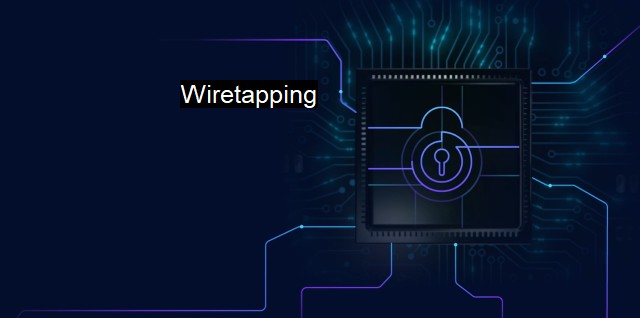What is Wiretapping?
Wiretapping: The Cybersecurity Threat to Electronic Communications and Sensitive Data
Wiretapping with the term refers to the interception of electronic communications without the consent of the parties involved. It can be seen as a form of eavesdropping, often carried out surreptitiously, with the goal of gaining unauthorized access to sensitive information. Wiretapping normally involves monitoring telephone and internet conversations by recording them or decoding in real-time by law enforcement and other nefarious entities for various purposes: personal, professional, or political.In the digital world, wiretapping has escalated to intercepting not just voice communications but also computer data, emails, and even cellular data. This practice is mainly illegal except if sanctioned by law enforcement agencies having necessary legal permissions – echoes of the infamous Operation Prism by the National Security Agency (NSA) in the USA that unleashed a global debate on privacy intrusion in the name of national security.
One might wonder how wiretapping in information technology takes place? Wiretapping targets the communications amongst nodes in networks where the transmission of packets of data between an original source and destination may be intercepted, mirrored, and analyzed for any valuable data information discreetly without informing the communicating parties. These attacks often exploit vulnerabilities in security mechanisms often located in network edges where data traffic peaks.
Advancements in technology have heralded new types of wiretapping methods. Software wiretaps or soft taps dominate now where algorithms catch and process data, replacing hard or physical taps requiring access to wires or xerographic photocopy circuit of valid data for copying. Gigantic volumes of intercepted telecom data en route is no longer manually scanned instead harvested by developing triggering keywords or phrases referred to as sniffers in the cybersecurity domain.
From a cybersecurity perspective, wiretapping is seen as a serious breach of security and privacy making prevention and detection of such activities incredibly vital. Antiviruses play a crucial role in counteracting the potential threats of wiretapping. An antivirus includes functionalities to detect malware designed for wiretapping activities. Several antiviruses have been designed to discover this kind of malicious code, alert the user, and delete or neutralize it before it does any substantial damage.
The use of encrypted communications and constant revaluation of security protocols is one method that helps in making the wiretapping effort more complicated if not totally impossible. One must emphasize that encryption serves as a sturdy fortress as it incorporates mathematically complex cryptographic keys rendering intercepted data computationally impractical to break – a cornerstone concept of secure communication preventing unauthorized interception.
Good browsing practices and awareness is also pivotal. Digital hygiene adherence where one deploys safe actions online, avoiding suspicious emails, attachments, happens to be one of the most simplistic yet significant things that one can do to guard against wiretapping attempts.
The role of Virtual Private Networks (VPNs), trusted antivirus software, and avoiding public Wi-Fi networks also offers buffers safeguarding your data from unwanted interceptions. Remember, digitally thieving entities target the least hanging digital fruits – unsecured communications – prompting the wisdom of garnering robust protection mechanisms.
Part of wiretapping's attraction for intruders is its stealthy nature, making the perpetrator’s identification extremely tough. This ascends the need for strong legislation to criminalize and bring the culprits to justice while balancing the conflicts between privacy and well-intentioned surveillance.
In the context of escalating cybersecurity threats and privacy authorization breaches masked amidst technological advances, wiretapping's ethical questions are more pertinent than ever. As the boundaries of what is possible continue to stretch, both individuals and organizations should put robust measures in place, to keep their communications and information safe. Cybersecurity and antivirus protection measures should always stay adaptive to prevent wiretapping, protect user privacy and retain the open nature of communication that the digital age promises.

Wiretapping FAQs
What is wiretapping in cybersecurity?
Wiretapping is the practice of intercepting and recording telephone or internet conversations, typically for the purpose of surveillance or espionage. In cybersecurity, wiretapping refers to the interception of digital communication and data transmission.How does wiretapping affect antivirus software?
Wiretapping can have a negative effect on antivirus software because it can be used to bypass or evade detection. If a hacker wiretaps a computer network or transmission, they can intercept and modify data before it reaches the antivirus software, thus making it difficult for the software to detect and prevent malware.Is wiretapping illegal?
Wiretapping is illegal in most cases, unless it is authorized by a legal warrant or court order. Wiretapping without authorization is a violation of privacy and can result in criminal charges. However, there are exceptions in some cases where wiretapping may be permitted, such as in law enforcement investigations with a warrant.What can individuals do to protect themselves from wiretapping?
Individuals can protect themselves from wiretapping by using encryption and secure communication channels. Using a virtual private network (VPN) can encrypt online data transmissions, making it more difficult for hackers to spy on internet activity. Additionally, individuals should avoid using public Wi-Fi networks and use strong password protection to prevent unauthorized access.Related Topics
Cybersecurity Threats Network Monitoring Data interception Malware Detection Antivirus Software
| | A | | | B | | | C | | | D | | | E | | | F | | | G | | | H | | | I | | | J | | | K | | | L | | | M | |
| | N | | | O | | | P | | | Q | | | R | | | S | | | T | | | U | | | V | | | W | | | X | | | Y | | | Z | |
| | 1 | | | 2 | | | 3 | | | 4 | | | 7 | | | 8 | | |||||||